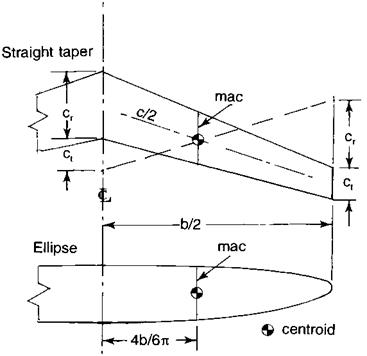Layout Principles
6.1.1 Subsonic Airplane Balance
Subsonic tail-last (not canard) airplanes are generally balanced to bring their centers of gravity near the wing-alone aerodynamic center. This is the point at which the wing’s pitching moment coefficient is invariant with angle of attack. For reasonably high wing aspect ratios, the wing-alone aerodynamic center is near the 25-percent point behind the leading edge of chord line passing through the wing’s center of area. This chord line is called the wing’s mean aerodynamic chord or mac. Figure 6.1 shows the simple geometric construction defining the mac for straight-tapered and elliptical wings.
Tailless airplanes must have their centers of gravity ahead of the wing aerodynamic center or 25-percent mac point to be inherently statically stable. If the wing is swept back, it can be trimmed at a reasonably high lift coefficient with trailing-edge-up deflections of its elevons. The degree of static stability desired and the maximum lift coefficient obtained are interrelated. Tailless airplanes can have their centers of gravity behind the wing
|
Figure 6.1 Geometrical constructions for the mean aerodynamic chord (mac) on straight-tapered and elliptical wings. |
aerodynamic center if static stability is provided by artificial means or stability augmentation (see Chapter 20). Longitudinal trim then requires trailing-edge-down elevon. This increases effective wing camber, with beneficial effects on performance (Ashkenas and Klyde, 1989).
The canard configuration, abandoned after 1910 by its inventors, the Wright brothers, has been revived in recent years, notably by Burt Rutan, in the belief that the arrangement provides natural stall prevention (see Chapter 17, Sec. 2). Also, trimming with an upload is thought to reduce induced drag, although this has been disputed. The neutral point, or center of gravity for neutral stability, of canard airplanes is considerably ahead of the 25-percent point of the wing mac. On the Rutan machines, fuel tanks are fitted in triangular leading-edge extensions to keep the fuel near the airplane’s center of gravity.














